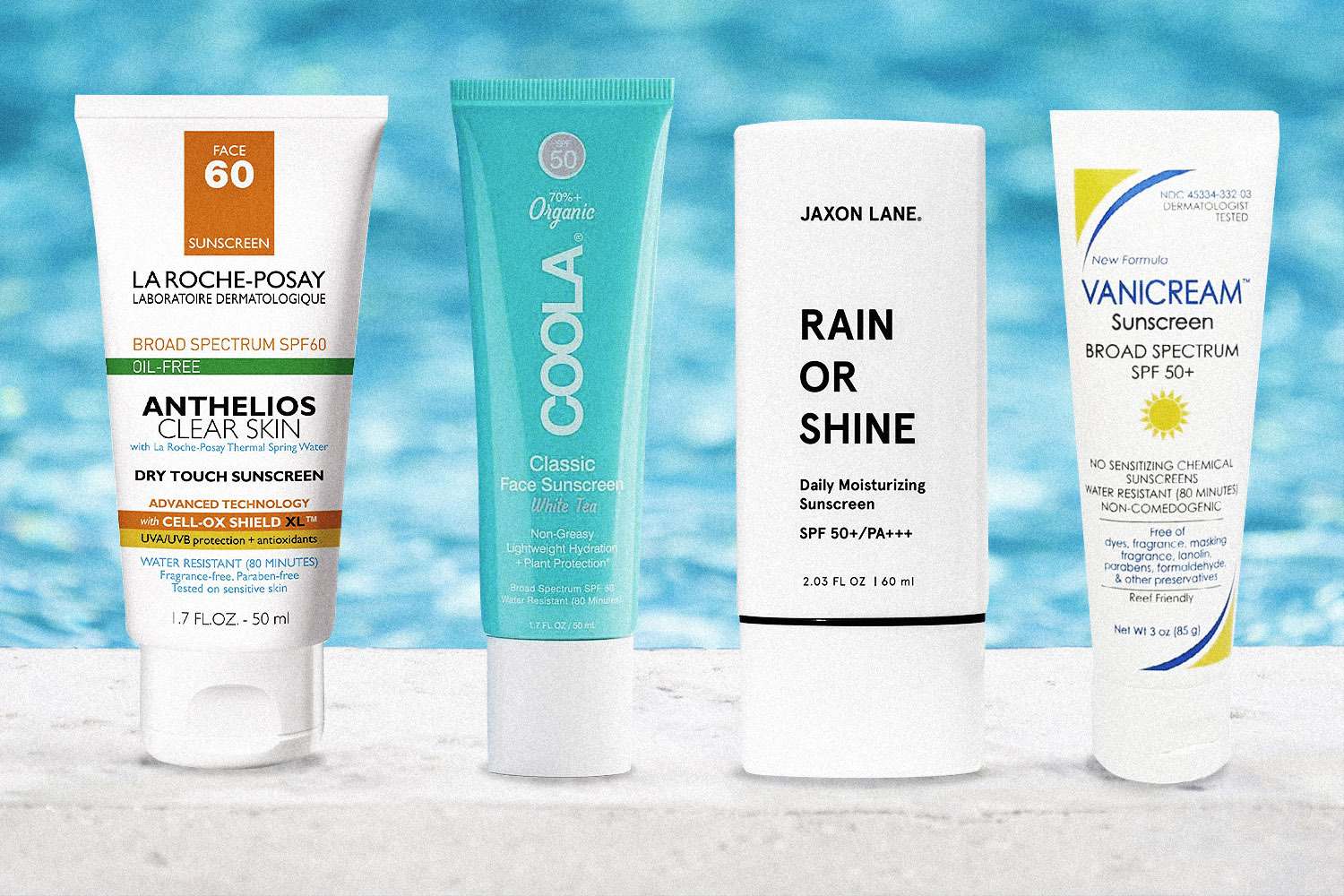By now you should be cognizant of just how bad the sun is for the skin. It’s really bad. Like really, really, really bad — and it’s even worse for men, who by age 80, are three times more likely to develop melanoma than women. Hopefully, these grim stats will encourage you to lather on the SPF heavy this summer, and maybe wear a shirt while you mow the lawn. But it is, of course, summer and there’s a reason skin cancer rates are scarily high: most of us love a splash of color. Your desire for a glowing, sun-kissed full-body tan is understandable, but there’s a way to achieve bronzed god status without frying off your skin cells. It’s time to get acquainted with sunless tanning.
So we dialed up Liz Pino, an esthetician and spray tan artist at Los Angeles’ premier Queen Bee Salon & Spa, who’s spray-tanned almost all of Hollywood, along with a few NFL players, for the lowdown on all things fake tanning — from professional spray tans to at-home self-tanning tips and tricks.
And before you assume that sunless tanning isn’t for your burly, manly self, a reminder that self-tanning is entirely gender-neutral, and like hair transplants and botox, more men are fake tanning than you might expect. “I’ve spray-tanned some of the most masculine guys. NFL football players. Every type of guy out there,” says Pino. “I don’t even think women really bat an eye at it anymore. I have so many married couples that come in and do it together. Just don’t worry about it. There’s no gender in tanning.”
How does sunless tanning work?
Tanning products contain a color additive called dihydroxyacetone (DHA), which is a sugar derived from plants like sugar beets and sugar cane that reacts with amino acids in the skin’s top layer (the epidermis) to darken skin, explains Pino. ” If you slice an apple in half and leave it on the counter, or if you leave your banana open, what happens? It turns brown. Air oxidizes this chemical on your skin.”
The FDA has approved DHA for external application to the skin, but states it should not be inhaled or applied to the mucous areas like the eyes, lips and nose since the risks of doing so are still unknown, which is why spray tanning booths are not approved by the FDA, it can be difficult to avoid exposure while in them. Depending on where you go, some tanning technicians will supply nose plugs and goggles. Still, research on the effects of DHA is preliminary and most dermatologists, including the American Academy of Dermatology Association, agree that sunless tanning is a way safer alternative to sun-bathing.
Before the tan
While women often shave before a spray tan — mainly to avoid scrubbing the tan off with a razor afterward — shaving prior to your appointment really depends on the look you’re going for. If you’re planning to shave your face or any other part of your bod, it’s preferable to do it before tanning so the tan can penetrate better, though it’s not a total dealbreaker. “If you’re going to go on vacation and shave your face anyways, I’d probably say to shave just to get more of a tan penetration. When it comes to the face in general, it’s not really that necessary because I feel like even if you tanned and have some facial hair, just using clippers would be better,” says Pino.
What you definitely want to do, though, before a spray or at-home tan, is to exfoliate your body with an exfoliating scrub, brush or glove, and to moisturize (but not too much). “For most guys, I actually ask them to not only exfoliate but to actually moisturize before a spray tan,” says Pino. “Moisturize with a water-based moisturizer — but not excessively. I don’t want somebody coming in greasy, but just to give it more of a base. You got to think of your skin as a really nice canvas. If you’re going to paint on something super crusty and dry and brittle, well, it’s going to come off crusty, dry, and brittle.”
Since the tan is non-dermal and sits on the top dead layer of skin, you want your skin to shed as evenly as possible so you don’t end up with a patchy tan. “Exfoliating and getting it as moist as you can without being gooey and over-moisturized, you’re actually giving yourself a longer-lasting, more even tan,” she adds.
What to expect
If you’re looking to get a professional spray tan, do your research. “Make sure you go somewhere reputable. Go somewhere with a staff that knows their stuff, that knows the chemicals, that knows the ingredients, that knows the science behind it. There is an art to it. Unfortunately, spray tanners are a dime a dozen now,” says Pino.
And when choosing a shade, consult your technician. “What I do, is I look at the person and ask them a lot of questions, like, what happens when you go in the sun? Do you tan really easily?” says Pino who explains the amino acids in each person’s skin determine how well your skin will take to the tan.
The spray tans of yesterday had to be kept on for a full 24 hours before a wash, which got pretty messy. Now there are more practical bronzer solutions and even solutions that are clear, which Pino says a lot of men prefer, along with something called a rapid tan. “It’s the same sort of DHA process but in more of a fast-acting formula. With that, you’d want to leave on for one hour for a light tan, two hours for medium, three hours for dark then would just rinse off. It just takes the wait out of it.” So you’ve got options.
How to preserve your tan
When you get a spray tan, your first shower should be a very simple shower, says Pino. “If you were going to be doing a rapid solution, you’d just rinse your body without soap, then pat your skin dry and lotion. With a regular spray tan, the steps would be a little bit different. You would shower and use a mild soap on your important bits (underarms, groin area, butt, feet.) You don’t really want to suds up your tan too much because you’re going to start stripping it immediately. Then once out of the shower, pat dry and very, very, very, lightly moisturize. You never want to wipe with your towel. That terry cloth material can start to actually really rip a tan off if you’re not careful.”
Also be mindful that swimming in the ocean, pool or engaging in other water sports will strip your tan quicker.
“Some guys actually go out and buy tan extenders which are, say, Jergens Natural Glow. Anything that’s not going to throw immediate color on you but more of a gradual color on you. Anytime you do that, you put on what comes off in that day.”
Tips for applying self-tanner at home
The biggest mistake people make when applying a self-tanner themselves is where they start applying.
“For some reason, people apply a self-tanner as you would a lotion. Your arms, your hands, your legs. Those are the first places you shouldn’t start. You should start inside out. Torso out,” says Pino. The reason being, your arms, legs and appendages are far drier than the torso. “You want to work yourself from your heart outwards. Then as the tanner starts to dissipate, you work it towards your drier areas. The drier the skin, the more tanner absorbs, so the darker that area gets. You want to put it on your least dry areas so the concentrate is heavier. Even when you’re doing the [tanning] lotions, it should be fluttered out.”
As for applicators and self-tanning products, Pino recommends a self-tanning mitt and a foam self-tanner. “Foam self-tanners tend to give a more even color. People are over-doers. You’re going to pump this foam into your self-tanning mitt and assume you pumped all this foam in your hand when really you didn’t. It’s aerated, it’s fluffed. It just looks like you’ve used a lot when really you’ve actually used the right amount.”
Foam is also easier to manipulate. While tanning towels and tanning water have their perks, foam is beneficial for first-timers since you can actually see where and how you’re applying it. “The other thing is, start with a gradual self-tanner versus one with a ton of color in it that’s gonna throw you to your darkest shade” adds Pino.
And what to do if you’ve made a terrible tanning blunder? “The main areas on the body that have an ‘oops’ usually are the hands and the feet. Some of the tools that I like to use are literally Mr. Clean Magic Erasers. Don’t put it all over your body, but it literally will take tanner right off your hands.”
And yes, you still need to wear SPF
“Some people have this crazy theory that a spray tan protects them in the sun. It actually gives you zero SPF protection at all,” says Pino. When it comes to applying an SPF on top of your fake tan, choose one that’s a bit more natural, more absorbent, and a little less sticky. If you’re rubbing on a greasy sunscreen or lotion with a lot of mineral oil in it, it most likely will break down your new tan.
This article appeared in an InsideHook newsletter. Sign up for free to get more on travel, wellness, style, drinking, and culture.
























